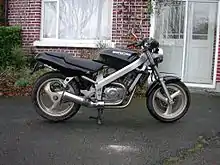Honda NT650
The Honda Hawk GT NT650 motorcycle was designated as model RC31 and was designed by Toshiaki Kishi, and was the second Honda with "Pro-Arm" suspension bike after the RC30 VFR750R. The RC model designation is for bikes up to 750 cc, though the Honda Pacific Coast (PC800) has an engine of more than 750 cc and a model designation of RC34.

 | |
| Manufacturer | Honda |
|---|---|
| Also called | Hawk GT, Bros, RC31 |
| Production | 1988–1991[1] |
| Class | Naked bike |
| Engine | 647 cc (39.5 cu in), four-stroke, 52° V-Twin |
| Top speed | 110 mph (180 km/h)[2] |
| Power | 58 hp (43 kW) (claimed)[1] 37.5 hp (28.0 kW) (rear wheel)[1] |
| Torque | 31 lb⋅ft (42 N⋅m) (rear wheel)[1] |
| Transmission | 5-speed, manual, chain final drive |
| Brakes | Front: disc Rear: disc |
| Wheelbase | 56.3 in (1,430 mm) |
| Seat height | 30.4 in (770 mm) |
| Weight | 393 lb (178 kg) (dry) 412 lb (187 kg) (wet) |
| Fuel capacity | 2.9 gal |
The Hawk GT was one of the first modern naked bikes along with the Yamaha SRX, which were both released several years before the Ducati Monster and eventually the Suzuki SV650. The Hawk GT is often described as a cult bike.[3]
North American model
The US model NT650, Hawk GT 647, RC31 was introduced in 1988 and produced through 1991. It has an aluminium box frame with the separate rear frame bolted on, and a chain drive single-sided swing arm.
Priced above other entry-level models and only slightly below many 600cc sport bikes, the Hawk GT did not sell well in American markets.[4]
There are only very minor changes between the 1988 model year and the 1989-1991 model years. In 1989, the front suspension damper rods were changed to have only two (rather than four for the 1988) holes. The front brake calipers were also changed to have screw-on covers over the mounting pins. In 1991, the oil lines were run internally through the engine, rather than externally. The Canadian model was identical to the US model except for the colors.
The 1988 model had a wet weight of 412 lb (187 kg). The 650 cc engine had an output of 58 hp (43 kW) @ 5000 rpm.[5]
European model
A cousin to the Hawk GT, the NTV 600 'Revere' was available in Europe from 1988 to 1992.[2] It had an integrated steel frame, larger fuel tank (19 litres or 4.2 imperial gallons), a lower and stubbier silencer, shaft drive, single-sided alloy swinging arm at rear with adjustable monoshock and a centre stand. It was launched a 'gentleman's' motorcycle but was seen as expensive for what was on offer.
The 600 Revere was replaced in 1993 by the bored-out NTV650 (the Revere name being dropped in the u.k), with a cheaper specification (including tubular handlebars instead of alloy bars, cheaper instruments and horns, some supplied without a centre stand), and continued with the 'stubby' silencer until '95 and later models got a full length silencer to comply with updated noise regs. The price was reduced compared to the Revere, and this later model sold better.
The NTV650 was replaced in 1998 by the Spanish built NT650V Deauville, a much heavier fully faired model with integral small panniers and a steel double sided swinging arm.
Japan model

Named the Bros in Japan, (The Model name Bros being derived from Brothers in reference to the 400cc and 650cc versions which were conceived together as brothers), the NT came in 400 and 650 cc (24 and 40 cu in) versions. After Honda stopped exporting the Hawk in 1992, they continued the Bros in Japan for one more year. A close ratio gear box (which drops into the Hawk) different wheels, and lower clip-ons were the major changes. A Motor Cycle News review said the Bros 400 is "heavy, underpowered and outdated, ... but surprisingly nice to ride – they’re well balanced, steer well and the engine is flexible, torquey and characterful given its 33bhp output. The Bros has a comfy, semi-upright café racer riding position."[6]
Notes
- "Forgotten Middleweight: 1988-1991 Honda NT650 Hawk GT". Motorcycle Classics. July–August 2014. Retrieved July 13, 2017.
- HONDA NTV650 (1988-1997) Review, Motor Cycle News, November 24, 2006, retrieved July 13, 2017
- Assoc, American Motorcyclist (June 2007), "Cult Bike!", American Motorcyclist, p. 22
- Wu, Frank H. "My First Motorcycle: The Honda Hawk GT". Huffington Post, November 11, 2013.
- Cycle World. June 1988. Pg. 34
- "HONDA BROS 400 (1988-1992) Review". Motorcycle News. November 4, 2009. Retrieved July 13, 2017.
References
- "The 10 best motorcycles of 1988. (evaluation)", Cycle World, vol. 27 no. 10, p. 27, October 1988
- "1989 Honda NT650 Hawk GT; The bike that changed my life", Motorcyclist, p. 15, October 2009
- Assoc, American Motorcyclist (February 1996), "Cult Bikes; A legend in your own mind?", American Motorcyclist, pp. 23–26
- Edwards, David (June 1988), "The view from the real world. (3 Cycle World readers try out the Honda Hawk GT)", Cycle World, vol. 27 no. 6, p. 40
- "Honda CB-1, 1989-1990", Motorcyclist, p. 95, December 2000
- "Honda Hawk GT; bird of a different feather. (evaluation)", Cycle World, vol. 27 no. 6, p. 34(6, June 1988
- Girdler, Allan (July 1990), "Standard time. (motorcycles) (evaluation)", Cycle World, vol. 29 no. 7, p. 26
- Miles, Matthew (September 1991), "Going British on a budget. (customizing a Honda Hawk GT 647 motorcycle)", Cycle World, vol. 30 no. 9, p. 54
External links
| Wikimedia Commons has media related to Honda Hawk. |
- Kelbrick, Darryl; Hine, Nick (2006), Honda BROS ( Hawk GT ) Road Test (YouTube), DrivenandRidden.com
